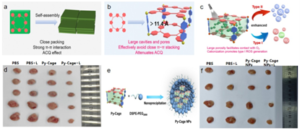The advantages of minimal invasiveness, excellent biocompatibility, and high spatiotemporal control manners have enabled photodynamic therapy (PDT) to be utilized as a novel alternative to conventional cancer treatment approaches. PDT relies on photosensitizers (PSs) to photochemically react with the ground-state oxygen molecules (oxygen, 3O2) or small molecules, generating highly toxic reactive oxygen species (ROS) under light irradiation in situ, to further induce tumor cell apoptosis or necrosis, vascular damage or cancer-mediated immunity, for example.
Since the first discovery of PSs based on hematoporphyrin derivatives (HpD) in 1960, the porphyrin-based PSs and their PDT performance have been extensively explored. Currently, various porphyrin-based PSs with different structures such as verteporfin, porfimer sodium, temoporfin and photocarcinosin have been approved for clinical practice. Despite great progress in clinical practice, the ROS generation of these porphyrin-based PSs is still far from satisfactory. One of the main issues is their large planar and rigid structures, which tend to form tight aggregates with strong π…π interactions at high concentrations in aqueous solutions or at tumor tissues. Such π…π stacking will cause diminished fluorescence and compromised ROS, leading to low PDT efficacy.
To weaken π…π stacking of porphyrin-based PSs, boost the generation of ROS, and enhance the PDT efficacy, work by Zhu, Zhang et al recently reported a novel biocompatible pure organic porphyrin nanocage (Py-Cage) with significantly improved ROS generation and PDT performance. Their design of the Py-Cage highlights the large cavity and long distance which effectively weaken the π…π stacking effect of porphyrins within the nanocage. Hence this Py-Cage exhibits excellent anti-ACQ features at high concentrations in aqueous solution (Figure 1a,b,c).

Fig 1. (a) and (b) Schematic comparison between traditional planar porphyrin-based photosensitizers and the porous porphyrin nanocage in attenuating the ACQ effect. (c) Schematic illustration of the enhanced ROS generation for cationic organic nanocage Py-Cage. (d) Tumor pictures of 4T1 tumor-bearing mice after different treatments (for Py-cage samples). (e) Schematic of Py-Cage NPs synthesized by a nanoprecipitation method with DSPE-PEG2000 as the encapsulation matrix. (f) Tumor pictures of 4T1 tumor-bearing mice in different groups (for Py-cage NPs samples). Reproduced from DOI: 10.1039/D3MH01263H with permission from the Royal Society of Chemistry.
A systematic comparative investigation shows that the Py-Cage can largely boost ROS generation that is superior to its PyTtDy precursor as well as widely used PSs, including Chlorin E6 (Ce6) and Rose Bengal (RB). Having established the excellent ROS generation and bright fluorescence of the Py-Cage, the team then evaluated its in vitro PDT performance using mouse breast cancer 4T1 cell. The data shows the Py-Cage can generate a large amount of ROS in cells under white light irradiations to induce cell apoptosis and death. Encouraged by the very promising in vitro results, Zhu, Zhang et al. further conducted in vivo PDT trials of the Py-Cage using a 4T1 tumor bearing mouse model. Their findings indicate that the tumors in the Py-Cage+light group showed the smallest sizes and lowest tumor weights among all the tested groups (Figure 1d), reflecting the best tumor growth inhibition performance of Py-Cage under light. The biocompatibility of the Py-Cage was also investigated by analyzing the blood routine and biochemical parameters of the rats after 48 h injection through tail veins. All the results show that the Py-Cage does not cause infection and bleeding symptoms and no damage to the liver and kidney function was observed. Other parameters such as cholesterol (CHO), triglyceride (TG), high-density lipoprotein cholesterol (HDL), low-density lipoprotein (LDL), glucose level were also not affected by Py-Cage. Moreover, the team prepared the Py-Cage nanoparticles by a nano-precipitation method to improve its water disability and biocompatibility. Similar in vitro and in vivo PDT experiments with these Py-Cage NPs were conducted and the NPs also proved to be excellent in biocompatibility and PDT efficacy (Figure 1e,f).
In summary, this work demonstrated the first porphyrin-based pure porous organic nanocage (Py-Cage) with a large cavity volume to promote both type-I and type-II ROS generation. Through comprehensive in vitro and in vivo studies, the Py-Cage proved to be extremely powerful in PDT with excellent biocompatibility and enhanced anti-tumor efficacy. The design of Py-Cage with a pure organic porous skeleton could avoid the π…π stacking to fully utilize the excited triplet state of PSs to generate ROS. This design strategy will offer enormous prospects for preparing novel and effective PSs with excellent biocompatibility for PDT and related phototheranostic applications.
To find out more, please read:
A biocompatible pure organic porous nanocage for enhanced photodynamic therapy
Zhong-Hong Zhu, Di Zhang, Jian Chen, Hua-Hong Zou, Zhiqiang Ni, Yutong Yang, Yating Hu, Ruiyuan Liu, Guangxue Feng, Ben Zhong Tang
Mater. Horiz. 2023, 10, 4868-4881, DOI: 10.1039/D3MH01263H
About the blogger

Quan Li is currently a Professor at Tianjin University of Traditional Chinese Medicine and a member of the Materials Horizons Community Board. Prof. Li’s research lab focuses on the design and preparation of soft matter materials based on light-responsive molecular machines and Chinese herbal medicine for biomedical applications, including anti-cancer, skin disease treatment, and others.
|










